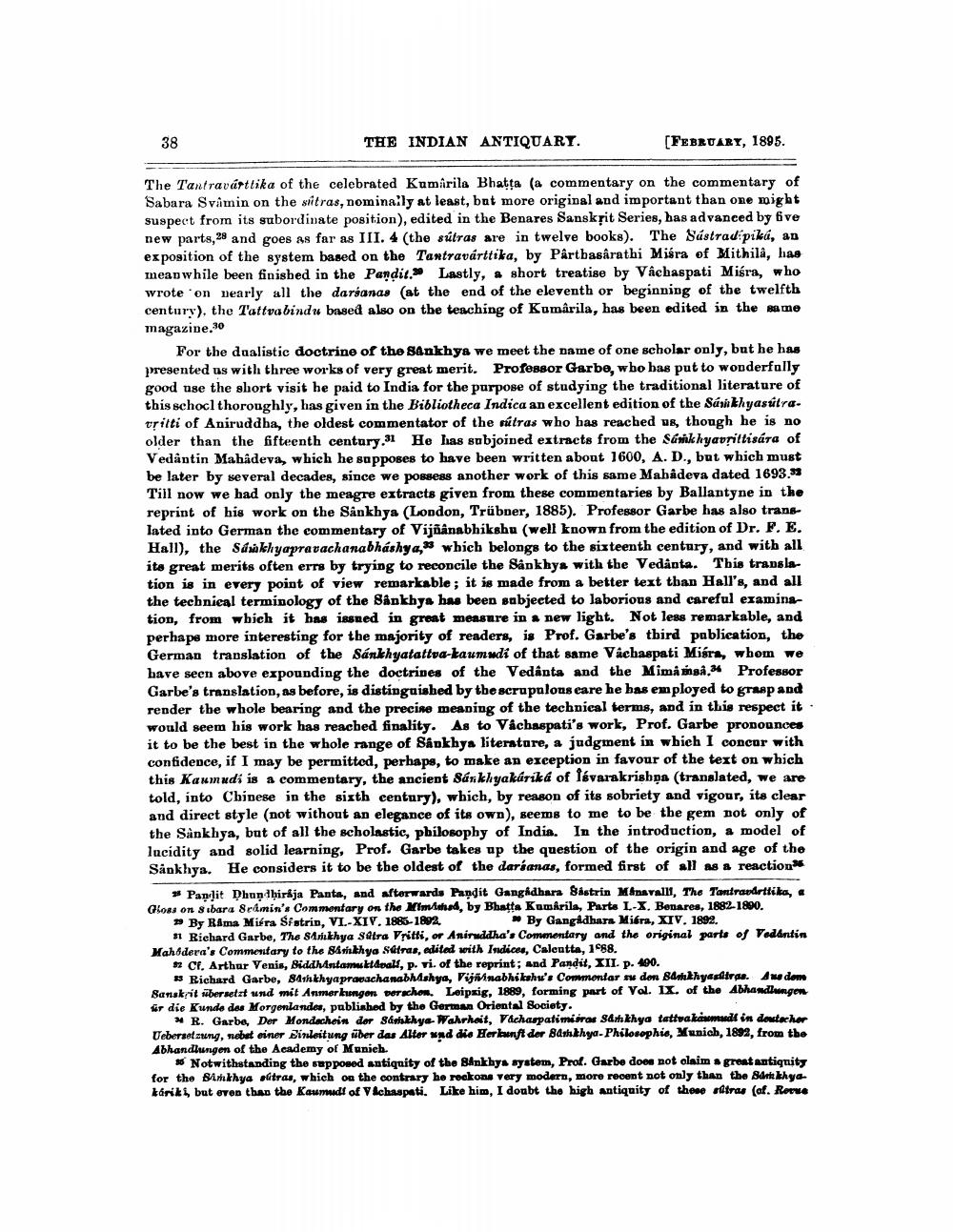________________
38
THE INDIAN ANTIQUART.
[FEBRUARY, 1895.
The Tantravárttika of the celebrated Kumirila Bhatta (a commentary on the commentary of Sabara Svimin on the sitras, nominally at least, but more original and important than one night suspect from its subordinate position), edited in the Benares Sanskrit Series, has advanced by five new parts, 28 and goes as far as III. 4 (the sútras are in twelve books). The Sústrad pika, an exposition of the system based on the Tantravarttika, by Pârtbasarathi Miśra of Mithila, has meanwhile been finished in the Pandit. Lastly, & short treatise by Váchaspati Migra, who wrote on nearly all the darsanas (at the end of the eleventh or beginning of the twelfth century), the Tattvabindu based also on the teaching of Kumarila, has been edited in the same magazine.30
For the dualistic doctrine of the Sankhya we meet the name of one scholar only, but he has presented us with three works of very great merit. Professor Garbe, wbo bas put to wonderfully good use the short visit he paid to India for the purpose of studying the traditional literature of this schocl thoroughly, has given in the Bibliotheca Indica an excellent edition of the Sárikhyasútra. uşitti of Aniruddha, the oldest commentator of the rútras who has reached us, though he is no older than the fifteenth century,31 He has subjoined extracts from the Sámik hyavrittisára of Vedantin Mahadeva, which he supposes to have been written about 1600, A. D., but which must be later by several decades, since we possess another work of this same Mahadeva dated 1693.93 Till now we had only the meagre extracts given from these commentaries by Ballantyne in the reprint of his work on the Sankhya (London, Trübner, 1885). Professor Garbe has also translated into German the commentary of Vijñanabhikshu (well known from the edition of Dr. F. E. Hall), the Sarikh yapravachanabháshy a * which belongs to the sixteenth century, and with all its great merits often errs by trying to reconcile the Sankhys with the Vedanta. This translation is in every point of view remarkable; it is made from a better text than Hall's, and all the technical terminology of the Sankhya has been subjected to laborious and careful examination, from which it has issued in great measure in a new light. Not less remarkable, and perhaps more interesting for the majority of readers, is Prof. Garbe's third pablication, the German translation of the Sankhyatattva-kaumudi of that same Vâchaspati Misra, whom we have seen above expounding the doctrines of the Vedanta and the Mimi nga. Professor Garbe's translation, as before, is distinguished by the scrupulons care he has employed to grasp and render the whole bearing and the precise meaning of the technical terms, and in this respect it. would seem his work has reached finality. As to Váchaspati's work, Prof. Garbe pronounces it to be the best in the whole range of Sankhya literature, a judgment in which I concor with confidence, if I may be permitted, perhaps, to make an exception in favour of the text on which this Kaumudi is a commentary, the ancient Sáskhyakáriká of Isvarakrisbņa (translated, we are told, into Chinese in the sixth century), which, by reason of its sobriety and vigour, its clear and direct style (not without an elegance of its own), seems to me to be the gem not only of the Sankhya, but of all the scholastic, philosophy of India. In the introduction, a model of lucidity and solid learning, Prof. Garbe takes up the question of the origin and age of the Sankhya. He considers it to be the oldest of the darsanas, formed first of all as a reaction
» Panjit Dhundbirkja Panta, and afterwards Pandit Gangadhara Bistrin Manavalli, The Tantraedrtlika, Clous on subara 8rimin'. Commentary on the immed, by Bhatta Kumirils, Parts L-X. Benares, 1882-1800. By Ráma Mifra Sistrin, VI-XIV, 1886-1892
By Gangadhara Mifra, XIV. 1892. #1 Richard Garbe, The Strikhya Satra Vritti, or Aniruddha's Commentary and the original parts of Vedantin Mahdera's Commentary to the Sarithya sdtras, edited with Indices, Caleutta, 1988.
Cr, Arthur Venis, BiddMntamuktdeal, p. vi. of the reprint; and Pandit, XIL p. 400. » Richard Garbe, 81th.khyapravachanabhashya, Vijnabhikshu's Commentar su der Banknyasi irae. sweden Banskrit bersetzt und mit Anmerkungen verschen, Leipzig, 1889, forming part of Vol. IX. of the Abhandlungen fir die Kunde des Morgenlandes, published by the German Oriental Society.
MR. Garbe, Der Mondachein der Samkhye Wahrheit, Vachaspatimiras Sdn khya tettvakaumud in deutscher Uebersetzung, nebot einer Sinleitung füber das Alter und die Herkunft der Bdshikhya Philosophie, Munich, 1892, from the Abhandlungen of the Academy of Munieh.
Notwithstanding the supposed antiquity of the Bankhys system, Prof. Garbe does not olaim great antignity for the Bankhya atras, which on the contrary he reckons very modern, more recent not only than the Birkhya. karikl, but even than the Kaumud of Vachaspati. Like him, I doubt the high antiquity of those stras (of. Revue




